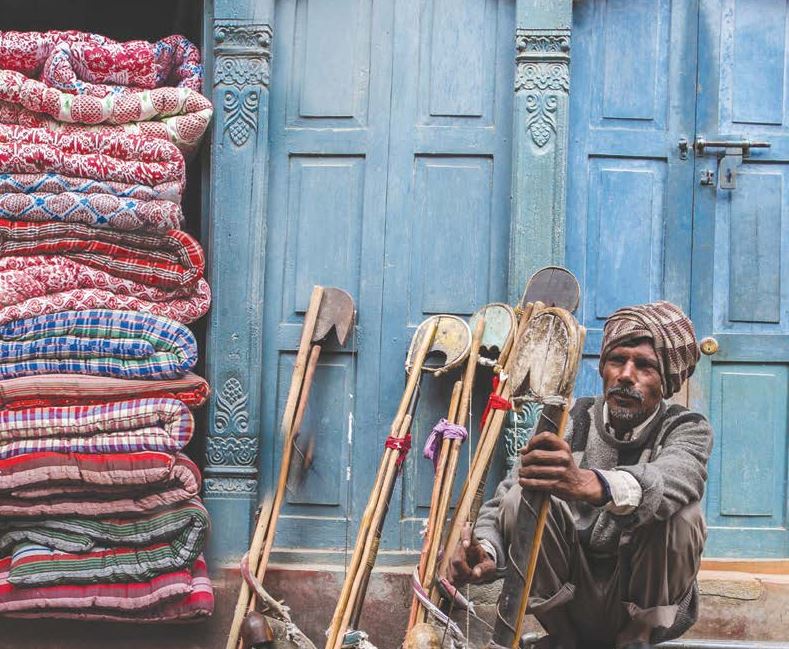Indian Rural consumers are emerging as highly cautious consumers of the branded mattress industry. What defines this set of consumers? Here is a glimpse at the growing influence of marketing on buying behaviour of rural consumers and behoof of mattress players.
More than 1.6 thousand Indian Rupees per month has been spent by 37 percent of rural Indian households, says Statista report ‘Distribution of monthly consumption expenditure in urban and rural India 2020’. The majority of the products and services are from the FMCG, durables and agricultural categories and they have been considered the main consumer products category in Rural India. This data may be a couple of years old, but we don’t see any significant changes in the spending power of an average rural Indian. This data has created a note that there is a very notable difference between rural and urban spending. Researchers have observed, that the requirements and offerings of rural products should not be an extension of urban products. Although the basic need is similar for the consumers of urban and rural India, yet rural India is very poor and negligent in various consumer product categories and specifically, when it comes to the mattress and furniture industry.
While looking at the history of mattresses and beds of the late 50s and 60s, you will witness prominently soft cotton fillings, animal fur and down feathers of birds being used for comfort, quality and royalty, while cotton beds and charpoys (made of bamboo and jute) being used by others as a mattress/bed.
In the nativity of India, there was a basic difference in the demand and the requirement for beds. A very traditional approach has been followed towards sleep products. Clearly, a new mindset was developed in post-colonial India in the mid90s, where the definition of quality of sleep was redefined. The mattress has started being considered as a quality of life, unlike a consumer durable. Besides, cotton beds are being used majorly by a larger population of semi-urban and rural areas. They need seasonal maintenance, unlike mattress, which needs minimal maintenance for a minimum of ten years.
Interestingly, with the advent of technology, a visible shift has been seen in the rural consumer focus towards comfort, quality and functionality of the mattress and the consumer product is prominently in the consumer buying requirement.
Technology interference has provided an opportunity for all industries to develop content, promote and customize as per customer requirements. Even the mattress industry in India, like any other industry, has shown a remarkable evolution in the last few years. As per a report from Statista Market forecast, $223.40m is the revenue of the Indian mattress market revenue in 2022, where the branded market owns 38.9 percent. The report forecasts growth of 9.79 percent (CAGR 2022-2026) annually.
In other words, the mattress industry has shown a profound transformation in the last couple of years. Income levels, health awareness, the development of real estate and the boost of technology have contributed to the accelerated growth of India’s mattress industry. According to the statistics provided with a CAGR (Compound Annual Growth Rate) of 13 percent, the mattress industry is showing a projection to reach 40 percent of the market by 2026.
“A new mindset was developed postcolonial India in the mid-90s, where the definition of quality of sleep had been redefined. The mattress has started being considered as a quality of life, unlike a consumer durable.”
statistics provided with a CAGR (Compound Annual Growth Rate) of 13 percent, the mattress industry is showing a projection to reach 40 percent of the market by 2026.
In spite of that, Indian rural consumers have a very unique psychological and behavioural profile. This explains why they need separate marketing strategies and efforts at innovative ways to approach rural consumers. Conventional beds are slowly developing a new category from the perspective of the rural consumer known as the “Science of sleep”. With the onset of technology, consumers are becoming more aware of sleep and health-related issues. A predominantly visible shift has been observed in the consumer’s attitude, in which now a day’s main focus is on the comfort and functionality of a product.
Rural India is also touched by the power of digital media and the networking population has started embracing the new media to communicate, explore and complement the brick-and-mortar culture. The online medium has become a versatile resource to promote, communicate and deliver a solution for customized issues of the consumer and explore the product on E-media. However, rural India has an entirely different perspective on the consumer services of online media as a delivery.
Connecting the dots between Traditional and Modern Mattress Industry
Dr. Devi Kumari, who is currently working as a faculty member in the area of General Management at Jaipuria Institute of Management, Indirapuram, Ghaziabad, Uttar Pradesh has incidentally done interesting research on rural India, found that approximately two-thirds of the population/ consumers of the country reside in rural areas. While agriculture is the major source of their income, they also do errands to accommodate their daily needs. She briefed that in the last few decades, there has been a significant change in the lives of rural India. People have improved their lifestyles with the change of time and market and significant lifestyle changes can be noticed. She described an instance where the rural population is becoming more conscious than ever towards their buying choices. An increase in their income status and a consciousness towards a comfortable and healthy life bring a change in their buying choices.
In one of her studies while pursuing her doctorate from IIT Kharagpur, she established that when it comes to bedding preferences, there is also a considerable change in the way rural India takes decisions. Mattresses are an asset that gives both comfort and a sense of class, a feeling of a rich lifestyle to the rural folks. Mattresses are no longer considered a luxury or an asset to showcase; rather, they are being preferred as a necessity, a possession that indicates the quality of a good life.

Commonly, masses of rural India consider sleep as a necessity, yet they are unable to correlate the bridge between health and sleep. Despite that, the internet has been facilitated in rural parts of the country, but sleep and health issues are not being sensitized by the authorities, locals and mattress players in rural areas of the country. It has also been identified that several factors are being identified into consideration before the buying process of mattresses among the rural population, but keeping in view various other challenges that rural India faces in day-to-day life. However, a rise in income levels, health consciousness, and development in hospitality and real estate are accelerating the growth of the Indian mattress market. The consumers of rural India are not connected with the mattress, due to their disconnection and unawareness of the benefits of the mattress.
In spite of that, Indian rural consumers are also looking into quality products and are also being recognized as price-sensitive consumers.
- In the history of mattresses and beds of the late 50s and 60s, you will witness prominently soft cotton fillings, animal fur and down feathers of birds used for comfort, quality and royalty. While at that time, cotton beds and charpoys (made of bamboo and jute) were used by others as a mattress/beds.
- With the advent of technology, a visible shift has been seen in the rural consumer focus towards comfort, quality and functionality of the mattress and the consumer product is prominent in the consumer buying requirement.
- Indian Rural consumers have a very unique psychological and behavioural profiles. This explains why they need separate marketing strategies and efforts at innovative ways to approach rural consumers.
- A predominantly visible shift has been observed in the consumer’s attitude, in which now a day’s main focus is on the comfort and functionality of a product.
- The online medium has become a versatile resource to promote, communicate and deliver a solution for customized issues of the consumer and explore the product on E-media. However, Rural India has an entirely different perspective on the consumer services of online media as a delivery.
- In one of Dr Devi Kumari’s studies, she established that there is a considerable change in the way rural India takes decisions. Mattresses are no longer considered a luxury or an asset to showcase; rather, they are preferred as a necessity, a possession that indicates the quality of a good life.
- The consumers of rural India are not connected with the mattress, due to their disconnection and unawareness of the benefits of the mattress. Indian rural consumers are also looking into quality products and are also being recognized as price-sensitive consumers.
- Brand Management expert of rural areas Sachidanand Chaturvedi mentioned the fact that a mattress buying decision depends on various factors ranging from income status to the urgency of the requirement.
- Rural Indian consumers mostly haggle for a better price when purchasing a mattress because they typically do not have access to the same level of consumer protection or knowledge about prices as urban consumers as a result they often rely on the advice of family and friends.
- The rising health consciousness is driving the growth of the market as people are becoming more aware of the importance of a good night’s sleep. In contribution to the growth of the market, the changing lifestyle is another factor as people are now opting for more comfortable and ergonomic products.
- A specific product and pricing strategy might disrupt the traditional pattern of promoting mattress products and cater to the needs and requirements of the mattress in rural consumers.
- Branded organizations might implement psychological pricing and adopt innovative sales promotional strategies for Indian rural consumers, as this set of consumers is prone towards price sensitivity and trust in the mattress having a high lifetime value.
- Advertising via hoardings, wall paintings, mobile vans, kiosk setup and shop branding are some of the prominent strategies that can be used by marketers and branded industries while promoting the product in rural areas.
“The mattress industry has started moving from an unbranded industry to a branded market in the rural market also. The key challenge here is changing the mindset of rural people and an entire re-innovation marketing strategy needs to be designed from a rural consumer perspective.”
Mystery of Mattress in Rural India
India’s rural development is significant to the overall progress in the economic and social spheres of rural areas. The new medium has also manifested recognition of sleep propositions to the rural population too. However, the rural population have a lifestyle of going to bed early due to electricity, a work-life schedule and various other reasons to have a healthy sleep.
A majority of rural India still sleeps on hand-woven duress, rope beds, homemade gadda, local mattresses, or bamboo chatais and charpai. Rural citizens have different perceptions when it comes to their traditional and foam mattresses. Most of them still take a mattress as a highly expensive possession which can be compromised with other needs. In fact, there have been various elements responsible for their buying preferences for a mattress, such as economic background, readiness for buying, affordability, and managing with local mattresses.
There are several factors which have been identified when people in rural India plan to purchase a mattress. Although there have been profound lifestyle changes experienced by rural India in recent times.
Dr Devi Kumari, an expert in understanding the mindset of rural people and who also belongs to the rural area of Orissa, believes that comfort takes a step back so far as rural people are concerned. Decisions about buying a mattress still take time for rural people. People from rural India don’t recognize sleeping as a comfort. The reason is that they seldom give less preference to comfort, lifestyle and quality. Precisely, before thinking about buying a mattress for a family, they keep a stock of their budget, affordability of the mattress and necessity of the mattress. Their income status plays a significant role in deciding to buy a mattress. They prefer to take care of
Other necessary needs in their family, such as the education of their children, and grocery consumption of the family. When they are for various household needs, the need for a mattress for better sleep takes a back foot.
Brand Management expert of rural areas Sachidanand Chaturvedi mentioned that the picture is not always the same in rural and urban areas. The deciding power of rural India cannot be generalized. There is a mix of consumers found in the rural sector. Some prefer to buy a long-lasting mattress, while some rely on brands as a matter of fact. This underlines the fact that a mattress-buying decision depends on various factors ranging from income status to the urgency of the requirement.
When it comes to purchasing mattresses, rural Indian consumers have different buying habits than their urban counterparts. For one, they are more likely to purchase mattresses on sale or second-hand. The main occasion for buying is a wedding function in their family. They are also more likely to buy mattresses based on comfort and durability, rather than brand name or price.
“Decisions about buying a mattress still take time for rural people. People from rural India don’t recognize sleeping as a comfort. “
While in India, the market is flooded with innovative models of mattresses with beautiful designs, while there is no dearth of advertisements for branded mattresses, quite a time it is observed that high price tags could be a deterrent to buying a luxury bed. As for rural folks, it is not always brand-driven, it is also product-driven.
Sachidanand Chaturvedi observes that rural Indian consumers are also more likely to haggle for a better price when purchasing a mattress. This is because they typically do not have access to the same level of consumer protection or knowledge about prices as urban consumers. As a result, they often rely on the advice of family and friends when making a purchase.
He explains that with the increase in disposable income, urban people are spending on mattresses, yet rural people are still considering mattresses as luxury products and not a necessary product to buy. However, the rising health consciousness is also driving the growth of the market as people are becoming more aware of the importance of a good night’s sleep. The changing lifestyle is another factor that is contributing to the growth of the market as people are now opting for more comfortable and ergonomic products.
Cup of Tea for Branded Mattress Players
Sachidanand Chaturvedi, Head, of Training & Development at Ekon Solutions Pvt Ltd found that marketers may also look into the customized solution and one-stop solution method while promoting mattress products to rural consumers. He explained that a focused kind of spending is required on consumer products, such as identifying competitive strategy, as the traditional mattress has captured a significant proportion of the mattress industry in rural areas of India.
A specific product and pricing strategy might disrupt the traditional pattern of promoting mattress products and cater to the needs and requirements of the mattress in rural consumers. As Indian rural consumers are looking forward to more value-based pricing, specifically for a product which is going to be for them for a longer duration of time.
An important strategy of rural marketing specifically for the mattress industry is the proper segmentation of the rural market. The mattress industry has also started moving from an unbranded industry to a branded market in the rural market. The key challenge here is changing the mindset of rural people and an entire re-innovation marketing strategy needs to be designed from a rural consumer perspective. Branded organizations might implement psychological pricing and adapt innovative sales promotional strategies for rural consumers, as this set of consumers is prone towards price sensitivity and trust in the mattress having a high lifetime value.
The mattress industry might need to start fiddling with their shops, and websites and design content with customer expectation-based approaches to create a space in the rural market. Advertising via hoardings, wall paintings, mobile vans, kiosk setup and shop branding are some of the prominent strategies that can be used by marketers and branded industries while promoting the product in rural areas.
Exposure to television has increased the awareness of consumers. The rapid change in consumer purchasing is a compliment on the economic front. It can be contended that with the changing mindset towards the market and mattresses and a growing need for a comfortable life, there will be an optimistic change in the coming times. Moreover, creating awareness, promoting and assuring a comfortable, healthy lifestyle is a prerequisite in order to find a change in the mindset of rural people. Nevertheless, in the coming times, rural India will be keen on expanding its buying preferences while buying mattresses. A collaboration of omnichannel marketing and price-savvy Indian rural consumers brings brand loyalty, product innovation, customer satisfaction and need-based mattresses.


